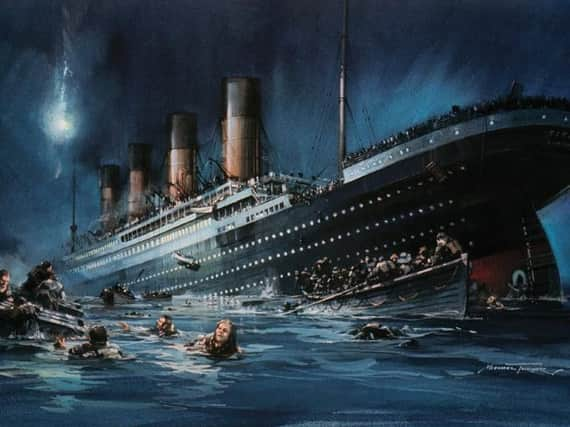Sussex suffragette survived Titanic iceberg catastrophe


The tale prompted me to research other Sussex connections to the sinking of the ship after it hit an iceberg in the Atlantic.
There were 2,224 passengers and crew on board and more than 1,500 died when “Titanic” went down slowly in the dark early hours in a calm sea. The death toll was so high because she only had sufficient lifeboats to hold 1,178 people.
Advertisement
Hide AdAdvertisement
Hide AdCharles Joseph Shorney of Oak Cottage, Herons Ghyll, near Crowborough, was one victim. In 1905, when Charles was fifteen, his mother died from blood poisoning after pricking her finger with a rusty sewing needle. Only-child Charles then lived at Oak Cottage with just his father, Austin. On one occasion Rudyard Kipling was invited in after his motorcar broke down nearby. The famous writer enjoyed a lunch while he waited for a mechanic to arrive and fix the vehicle.
In June 1906 at St John's Church, Heron's Ghyll, Austin Shorney remarried. The bride, Mary Anne Naughton, was thirty years younger than the groom. At the time Charles was working abroad as a valet. Fluent in French, he found employment in Paris and Cannes. Next he went to New York from where he returned home on the White Star liner “Oceanic”. The weather was so bad that a desperately seasick Charles vowed never again to travel with White Star.
Back in Sussex he found he now had a stepsister, Margaret Mary. He spent time at Oak Cottage before departing for New York where he had left a fiancé and a modest taxi business. A Brighton Thomas Cook clerk had recommended Charles sail on the brand new liner “Titanic”. Despite misgivings that it was a White Star ship he purchased ticket 374910 for just over £8.
Charles's last postcard home was sent from Queenstown (now Cobh) in Ireland and featured a photograph of the “Titanic”. He wrote: “This is the boat. She is a peach. She smashed into another boat leaving Southampton. There is great vibration in the stern. Get to New York next Thursday so will write again later. Sea quite calm.”
Advertisement
Hide AdAdvertisement
Hide AdShorney’s emphatic remark about “Titanic” striking another boat upon departure is very puzzling. This is because it contradicts other accounts that describe a collision with the moored “SS City of New York” being averted by just a few feet. As poor Charles Shorney went down with the “Titanic” we are left with a maritime mystery.
Edward Watson Ford was born in Mayfield in 1895 and along with four siblings was also lost. Their father hailed from Fletching and their mother, Margaret, came from the Isle of Skye. The couple married in Hadlow Down in 1890. The father deserted the family leaving Margaret to scratch a poor living rearing chickens. Her sister had gone to America in 1911 and found well-paid work as a domestic servant. Her letters describing a good life in Massachusetts so impressed Margaret that she decided to emigrate with the children. Travelling with them was an aunt, Elizabeth Johnston and her family, plus a friend, Phoebe Alice Harknett. Not one of the ten in the party survived.
The errant Ford father was later awarded five shillings per week compensation after filing a claim against White Star for the loss of his family.
One-time Eastbourne Bandstand musician John Wesley Woodward was one of those doomed stoic souls who played “Abide With Me” and other hymns on the deck of the “Titanic” as the ship went down. He is remembered on a blue plaque within the seafront bandstand. Jonathon Thorley of Brighton, a Lamp Trimmer, was a much luckier crewman; he escaped in Lifeboat Thirteen.
Advertisement
Hide AdAdvertisement
Hide AdMiss Elsie Edith Bowerman was an only child who lost her father in 1895 when she was just five years old. A very bright girl, after boarding school, Elsie lived in Paris before going to Cambridge University.
Around 1910 she joined Emily Pankhurst's movement campaigning for votes for women. Elsie lived with her mother, Edith, in St. Leonards-on-Sea. The pair planned a trip to North America and boarded “Titanic” as first class passengers. They were rescued from Lifeboat Six by the Cunard liner “Carpathia” and conveyed to New York from where the intrepid pair ventured as far west as Canada’s Klondyke and remote Alaska.
In September 1916 Elsie joined a Scottish women's hospital unit treating the wounded of Serbian and Russian forces in Rumania. She arrived to find both armies in full retreat closely pursued by the victorious Germans. The hospital unit hurried north into Russia. In 1917 Elsie was in St. Petersburg where she witnessed the Russian Revolution at first hand and recorded the tumultuous events in her diary.
Following the Armistice, Elsie took up law and was admitted to the Bar in 1924. When World War II loomed, she quit her legal practice and joined the recently-founded Women's Voluntary Services. She also worked for the BBC. In 1947 she went to New York to help set up the UN Commission on the Status of Women.
Advertisement
Hide AdAdvertisement
Hide AdElsie later returned to St. Leonards to be near her elderly mother. When Edith died, Elsie, then 64, retired to a country house near Hailsham where she passed away in 1973, aged 83. She is buried in Hastings cemetery.